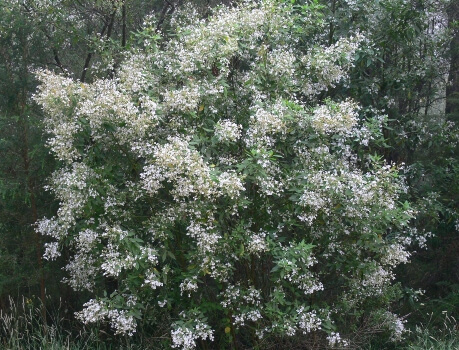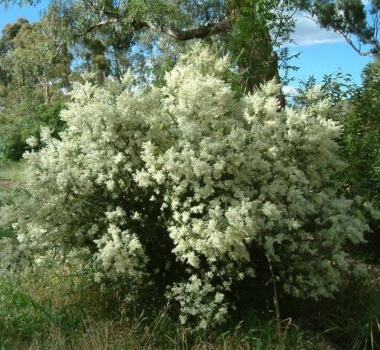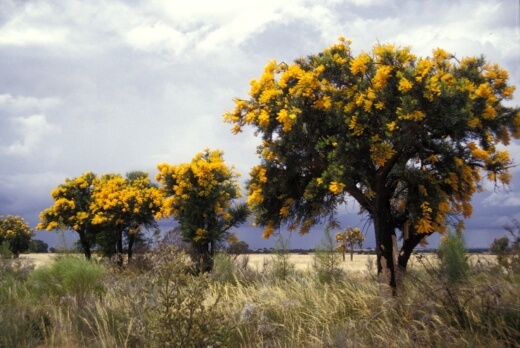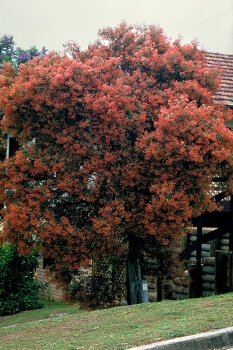I like to get in the Christmas spirit with as many decorations as possible, and my favourite kind of décor is the living kind. The NSW Christmas bush just makes it feel like Christmas so it’s no wonder this traditional Australian beauty is a popular gift and home decorator.
The white flowers that appear in red frames during December are my idea of getting festive. Bring on the red, white and green! In our how to grow and care guide, I’ll officially introduce you to the Christmas bush, and more specifically the NSW Christmas bush.
I’ll talk through how to care for your plant, how to propagate, pests and diseases, and lastly, some frequently asked questions about this iconic Australian native.
More...
Family: | Cunoniaceae |
|---|---|
Genus: | Ceratopetalum |
Species: | C. gummiferum |
Common Names: | NSW Christmas Bush |
Location: | Indoor or outdoor |
Type: | Tree |
Growth: | Up to 4 metres tall, Up to 2 metres wide |
Sun requirements: | Sun to part shade |
Foliage Colour: | Green |
Flower Colour: | White, cream, pink, purple |
Flowering: | Spring |
Fruit: | None |
Maintenance level: | Low |
Poisonous for pets: | Yes |
Introducing the NSW Christmas Bush

The Christmas bush is a wonderful choice for your outdoor garden or you can bring the festive feeling indoors and plant it in a pot. Your plant is a fan of a well-draining soil, and will be happy somewhere sunny, or even with a bit of shade.
Not a lover of frost, but can handle a light one here and there. The NSW Christmas bush is a small tree with a pleasing shape. It produces pink or red bracts or ‘flowers’ around Christmas time, hence the name, but also the colouring matches a festive theme. People often like to cut the flowers to put in a vase.
Christmas Bush Varieties
Here’s a fun fact - the Christmas bush is actually a collection of different plants that grow in most Australian states. Let’s look at a few other types below:
Victorian Christmas Bush

Source: yarraranges.vic.gov.au
This lovely lady produces white, pink or purple flowers in the summertime and provides nectar and a hiding place for native birds. The Prostanthera lasianthos grows in Victoria, Queensland, New South Wales, Australian Capital Territory, and Tasmania.
South Australian and Tasmanian Christmas Bush

Source: andreasensgreen.com.au
This variety produces small cream flowers. The flowers smell sweet and have a star shape, attracting lots of butterflies. Bursaria spinosa grows in all the states except Western Australia. This Christmas bush is also a popular choice for birds to make their nests.
West Australian Christmas Tree

Source: bgpa.wa.gov.au
This beauty has golden flowers that are magnificent and they smell like honey. Nuytsia floribunda is a type of mistletoe which provides food for insects, birds and mammals when food might be hard to find.
Honeyeater birds love mistletoes as it offers great shade but also protection. The West Australian Christmas bush is in fact the biggest mistletoe in the world.
Many people think they are weeds, but these plants are actually semi-parasitic and provide food and nesting.
How to Grow NSW Christmas Bush
The best method for Christmas bush propagation is with a cutting. It’s important to take a semi-ripe cutting around 10 to 15 centimetres in length and the best place to cut it is just below a leaf using a sharp tool.

Source: gardensonline.com.au
Quickly put your cuttings in a plastic bag and put it somewhere shady. If the weather is hot, you can store it in the fridge. Try and get your cuttings into their pots within a 12 hour period.
You can take off the lower leaves of the cutting and the soft tips. Dip your cuttings into hormone rooting powder and you can then plant them in containers with half potting compost and half sand or perlite.
Give plenty of water and then allow the cuttings to drain off. Cover your pots with a plastic bag to create a greenhouse effect, placing them somewhere light and warm and not directly in the sun. The potting mix or compost should stay moist but not soggy.
The best time to plant your seedling is during autumn and spring time. If you live somewhere that usually gets frost, then spring will be best so the plant can strengthen before the winter time.
Once you have planted your seedlings, you’ll need to water them often for around 6 weeks. When the plant has established itself, you can then adjust your watering schedule. Your soil type and location also influence how much water will be needed.
For more inspiration on Australian native plants, have a browse through our various plant profiles.
How to Care for your Christmas Bush

Source: climatewatch.org.au
Sunlight Needs
I would recommend that you plant or place your New South Wales Christmas bush somewhere with full sun or in a partly shaded spot.
Best Soil for Christmas Bush
I have found that this tree thrives in sandy, well-draining soil. If you have a clay soil for example, you could add gypsum and a quality garden mix. It’s also a good idea to protect your tree from the wind.
Watering Schedule
This is a thirsty tree when the weather is warm so be sure to water regularly in the spring and summer months.
Pruning NSW Christmas Bush
The idea of pruning doesn’t appeal to all plants but we’ve found that the New South Wales Christmas bush enjoys a light pruning around January or February.
A good guideline is when the red bracts are done with their bright and colourful show. If you want to make sure you have an abundance of flowering for the following season, it’s wise to prune flowering new wood only so that means old wood or hardwood is a no go.
Other than pruning your Christmas bush to increase flowering, you can also prune to maintain shape or fill your home with some lovely festive cuttings.
When to Fertilise Christmas Bush
We believe in putting something back after you take something out so on that note, when you’re done pruning in January/February, you can mulch the soil with compost or manure and then provide lots of water.
I’ve also heard that a dash of sulphate of iron, about 100g, around the plant actually enhances the colour for the following season.
If you need some help finding the best mulch for your garden, have a look at our ultimate guide which focuses on the basics of garden mulching.
Common NSW Chritmas Bush Pests and Diseases
Leaf-curling psyllids and scale can threaten the happiness and well-being of your New South Wales Christmas bush. Let’s have a look at these pests and how to deal with them in a little more detail.

Leaf-curling psyllids
The leaf-curling psyllids are also called jumping plant lice (the name alone is enough to give you the shivers and scratches). These pests actually burrow into the surface of the leaf and suck out the cell sap.
You’ll notice that the leaves will turn yellow and curl up and eventually they die. If the damage to your tree is quite substantial, you could do a weekly treatment of spraying the tree with neem oil or even an insecticidal soap.
This is sure to kill the psyllids. Pruning your tree doesn’t really help because the pests just jump away.
Refer to this guide on management of psyllids in NSW Christmas bush plantations for more info.
Scale insects
Scale insects are another type of plant sap feeder. They give off a sticky substance called honeydew so your leaves might look a little shiny, and it’s this honeydew that causes the start of sooty mould.
The best way to get rid of the scale pests is to prune off the branches and leaves of the tree that are infected. If you are only dealing with a few, you could remove them by hand or use a rubbing alcohol on cotton wool to wipe them off.
Christmas Bush Frequently Asked Questions

Source: anpsa.org.au
What are some of the popular varieties of the NSW Christmas bush?
It would definitely have to be ‘Albery’s Red’, which is quite big and provides stunning bright red ‘flowers’, hence the name. There is also ‘Red, Red, Red Christmas’ (you have to love these festive names), where the bracts actually become a darker red the older they get.
If you’re looking for something a little more compact, the dwarf 'Johanna’s Christmas’ won’t grow taller than 3 metres.
When does the Christmas bush actually bloom?
The red ‘flowers’ of the New South Wales Christmas bush aren’t really flowers. The tree produces its real flowers in the springtime. The flowers are quite small, a white to cream colour in a star shape and they don’t have a very nice smell.
The little leaves that protect the flower bud, also called sepals or bracts, then arrive after the flowers have died and these are the parts of the tree or plant that have that brilliant red colour all the way from November until about February.
Can you dry Christmas bush?
You can indeed dry and store Christmas bush for up to a month. Just don’t allow it to become frozen in the process.
Where does the botanical name for the NSW Christmas bush come from?
The scientific name Ceratopetalum gummiferum is actually a reference to the horn shaped petals but also because when the bark of the tree is cut, it actually makes a lot of gum.
How long does a Christmas bush cutting last for?
These beautiful cuttings can last up to 3 weeks once cut so prepare all your vases and bowls for a festive feast. Cut the stems at an angle with sharp scissors or shears and be sure to change the water often which helps the cuttings last even longer.
Why is my Christmas bush turning brown?
This could be a sign of overwatering so be sure to check your soil for signs of this. Rather let the soil dry out before you start watering again. If the tree starts turning brown after being fertilised, it could be that it has been over fertilised and you can flush the soil with water.
Looking for more plant profiles, inspiration for your garden, or just good advice on how to care for your plants? Sign up for our newsletter here.
Wrapping Up Our NSW Christmas Bush How to Grow and Care Guide
There are some things that just get me into the festive spirit and the Christmas bush is one of them (along with Christmas carols). What I love about this tree is that you get flowers in spring, and then the colourful bracts afterwards in time for the holiday season (and for a while after).
Just imagine filling your home with vases and pots of this Australian beauty, and even having an outdoor tree too, that you could decorate with family, or take lots of photos next to.
The Christmas bush is not high maintenance at all (another reason I love it so much), and with the right soil, a bit of pruning, and a whole lot of love, you’ve got a gorgeous feature tree that will bring plenty of smiles.
I’m certainly giving the Christmas bush a green thumbs up!
Published on October 3, 2022 by Lorri Hopkins
Last Updated on March 27, 2024




